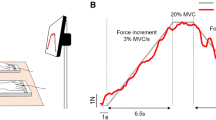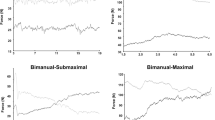Abstract
Bimanual movement disorders are common dysfunctions post stroke. This stroke study investigated bimanual force control capabilities to determine the effect of coupled bimanual movement training on bimanual coordination and motor synergy. Stroke participants (N = 11) completed three bimanual force control tasks at 5, 25, and 50 % of maximum voluntary contraction before and after coupled bimanual movement training. Root mean square error (RMSE), approximate entropy, correlation, and bimanual motor synergy were analyzed in two-way completely within-subjects ANOVAs (Test Session × Force Level: 2 × 3). Multiple linear regression analysis determined the relationship between RMSE and other force control measures. The analyses revealed three important findings: (1) RMSE decreased from baseline to posttest (2) negative correlation (e.g., error compensation) and bimanual motor synergy increased at 25 and 50 % after rehabilitation, and (3) increased bimanual motor synergy was strongly associated with decreased RMSE after training. The findings indicate that coupled bimanual movement training improved force control performance, bimanual coordination, and motor synergies. Indeed, the present findings extend bimanual motor synergies as a meaningful indicator for estimating task performance improvements. Finally, bimanual force control is a valid outcome measure in quantifying progress toward motor recovery post stroke.







Similar content being viewed by others
Abbreviations
- UCM:
-
Uncontrolled manifold
- MVC:
-
Maximal voluntary contraction
- RMSE:
-
Root mean square error
- ApEn:
-
Approximate entropy
References
Bertrand AM, Mercier C, Shun PL, Bourbonnais D, Desrosiers J (2004) Effects of weakness on symmetrical bilateral grip force exertion in subjects with hemiparesis. J Neurophysiol 91:1579–1585
Calautti C, Naccarato M, Jones PS, Sharma N, Day DD, Carpenter AT, Bullmore ET, Warburton EA, Baron JC (2007) The relationship between motor deficit and hemisphere activation balance after stroke: a 3T fMRI study. Neuroimage 34:322–331
Carson RG (2005) Neural pathways mediating bilateral interactions between the upper limbs. Brain Res Rev 49:641–662
Cauraugh JH (2004) Coupled rehabilitation protocols and neural plasticity: upper extremity improvements in chronic hemiparesis. Restor Neurol Neurosci 22:337–347
Cauraugh JH, Kim S (2002) Two coupled motor recovery protocols are better than one: electromyogram-triggered neuromuscular stimulation and bilateral movements. Stroke 33:1589–1594
Cauraugh JH, Summers JJ (2005) Neural plasticity and bilateral movements: a rehabilitation approach for chronic stroke. Prog Neurobiol 75:309–320
Cauraugh JH, Coombes SA, Lodha N, Naik SK, Summers JJ (2009) Upper extremity improvements in chronic stroke: coupled bilateral load training. Restor Neurol Neurosci 27:17–25
Cauraugh JH, Lodha N, Naik SK, Summers JJ (2010) Bilateral movement training and stroke motor recovery progress: a structured review and meta-analysis. Hum Mov Sci 29:853–870
Cauraugh JH, Naik SK, Lodha N, Coombes SA, Summers JJ (2011) Long-term rehabilitation for chronic stroke arm movements: a randomized controlled trial. Clin Rehabil 25:1086–1096
Davis NJ (2007) Memory and coordination in bimanual isometric finger force production. Exp Brain Res 182:137–142
Diedrichsen J, Hazeltine E, Nurss WK, Ivry RB (2003) The role of the corpus callosum in the coupling of bimanual isometric force pulses. J Neurophysiol 90:2409–2418
Doucet BM, Lam A, Griffin L (2012) Neuromuscular electrical stimulation for skeletal muscle function. Yale J Biol Med 85:201–215
Folstein MF, Folstein SE, McHugh PR (1975) “Mini-mental state”: a practical method for grading the cognitive state of patients for the clinician. J Psychiatr Res 12:189–198
Harris-Love ML, McCombe Waller S, Whitall J (2005) Exploiting interlimb coupling to improve paretic arm reaching performance in people with chronic stroke. Arch Phys Med Rehabil 86:2131–2137
Heffernan KS, Sosnoff JJ, Ofori E, Jae SY, Baynard T, Collier SR, Goulopoulou S, Figueroa A, Woods JA, Pitetti KH, Fernhall B (2009) Complexity of force output during static exercise in individuals with down syndrome. J Appl Physiol 106:1227–1233
Hidaka Y, Han CE, Wolf SL, Winstein CJ, Schweighofer N (2012) Use it and improve it or lose it: interactions between arm function and use in humans post-stroke. PLoS Comput Biol 8:e1002343
Hu X, Newell KM (2011a) Adaptation to bimanual asymmetric weights in isometric force coordination. Neurosci Lett 490:121–125
Hu X, Newell KM (2011b) Modeling constraints to redundancy in bimanual force coordination. J Neurophysiol 105:2169–2180
Hu X, Loncharich M, Newell KM (2011) Visual information interacts with neuromuscular factors in the coordination of bimanual isometric force. Exp Brain Res 209:129–138
Jorgensen L, Jacobsen BK (2001) Changes in muscle mass, fat mass, and bone mineral content in the legs after stroke: a 1 year prospective study. Bone 28:655–659
Kilbreath SL, Crosbie J, Canning CG, Lee MJ (2006) Inter-limb coordination in bimanual reach-to-grasp following stroke. Disabil Rehabil 28:1435–1443
Landau WM, Sahrmann SA (2002) Preservation of directly stimulated muscle strength in hemiplegia due to stroke. Arch Neurol 59:1453–1457
Latash ML (2008) Synergy. Oxford University Press, New York
Latash ML (2010a) Motor synergies and the equilibrium-point hypothesis. Mot Control 14:294–322
Latash ML (2010b) Stages in learning motor synergies: a view based on the equilibrium-point hypothesis. Hum Mov Sci 29:642–654
Latash ML (2012) The bliss (not the problem) of motor abundance (not redundancy). Exp Brain Res 217:1–5
Latash ML, Anson JG (2006) Synergies in health and disease: relations to adaptive changes in motor coordination. Phys Ther 86:1151–1160
Lodha N, Naik SK, Coombes SA, Cauraugh JH (2010) Force control and degree of motor impairments in chronic stroke. Clin Neurophysiol 121:1952–1961
Lodha N, Coombes SA, Cauraugh JH (2012) Bimanual isometric force control: asymmetry and coordination evidence post stroke. Clin Neurophysiol 123:787–795
Lukacs M (2005) Electrophysiological signs of changes in motor units after ischaemic stroke. Clin Neurophysiol 116:1566–1570
Marshall MM, Armstrong TJ (2004) Observational assessment of forceful exertion and the perceived force demands of daily activities. J Occup Rehabil 14:281–294
Montgomery DC, Peck EA (1982) Introduction to linear regression analysis. Wiley, New York
Murase N, Duque J, Mazzocchio R, Cohen LG (2004) Influence of interhemispheric interactions on motor function in chronic stroke. Ann Neurol 55:400–409
Nowak DA (2008) The impact of stroke on the performance of grasping: usefulness of kinetic and kinematic motion analysis. Neurosci Biobehav Rev 32:1439–1450
Pincus SM (1991) Approximate entropy as a measure of system complexity. Proc Natl Acad Sci USA 88:2297–2301
Pincus SM, Goldberger AL (1994) Physiological time-series analysis: what does regularity quantify? Am J Physiol 266:H1643–H1656
Ranganathan R, Newell KM (2008) Motor synergies: feedback and error compensation within and between trials. Exp Brain Res 186:561–570
Sarabon N, Markovic G, Mikulic P, Latash ML (2013) Bilateral synergies in foot force production tasks. Exp Brain Res 227:121–130
Scholz JP, Kang N, Patterson D, Latash ML (2003) Uncontrolled manifold analysis of single trials during multi-finger force production by persons with and without down syndrome. Exp Brain Res 153:45–58
Slifkin AB, Newell KM (1999) Noise, information transmission, and force variability. J Exp Psychol Hum Percept Perform 25:837–851
Stinear JW, Byblow WD (2004) Rhythmic bilateral movement training modulates corticomotor excitability and enhances upper limb motricity post stroke: a pilot study. J Clin Neurophysiol 21:124–131
Stinear CM, Barber PA, Coxon JP, Fleming MK, Byblow WD (2008) Priming the motor system enhances the effects of upper limb therapy in chronic stroke. Brain 131:1381–1390
Torre K, Hammami N, Metrot J, van Dokkum L, Coroian F, Mottet D, Amri M, Laffont I (2013) Somatosensory-related limitations for bimanual coordination after stroke. Neurorehabil Neural Repair 27:507–515
Vaillancourt DE, Slifkin AB, Newell KM (2001) Regularity of force tremor in Parkinson’s disease. Clin Neurophysiol 112:1594–1603
Wu YH, Pazin N, Zatsiorsky VM, Latash ML (2013) Improving finger coordination in young and elderly persons. Exp Brain Res 226:273–283
Acknowledgments
Funding from the American Heart Association is gratefully acknowledged in supporting this research with a Grant to JHC (#00093013). The authors thank the reviewers for their valuable suggestions on an earlier version of this manuscript.
Conflict of interest
None.
Author information
Authors and Affiliations
Corresponding author
Rights and permissions
About this article
Cite this article
Kang, N., Cauraugh, J.H. Force control improvements in chronic stroke: bimanual coordination and motor synergy evidence after coupled bimanual movement training. Exp Brain Res 232, 503–513 (2014). https://doi.org/10.1007/s00221-013-3758-z
Received:
Accepted:
Published:
Issue Date:
DOI: https://doi.org/10.1007/s00221-013-3758-z




